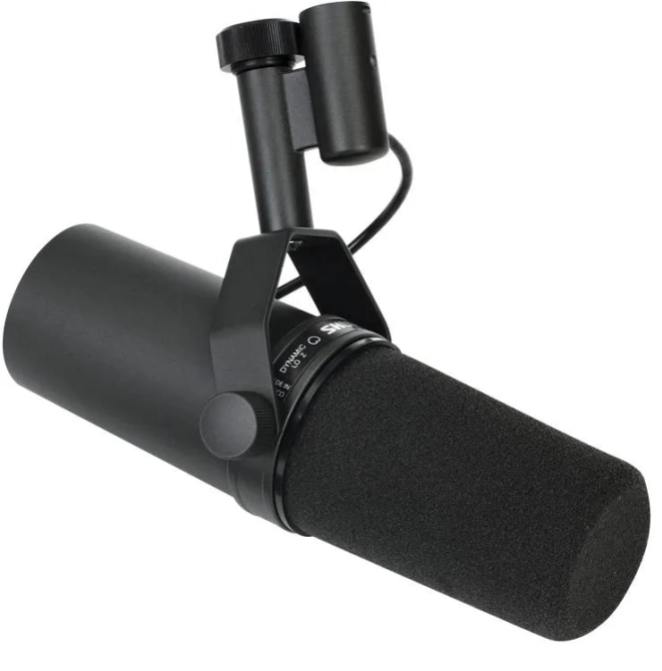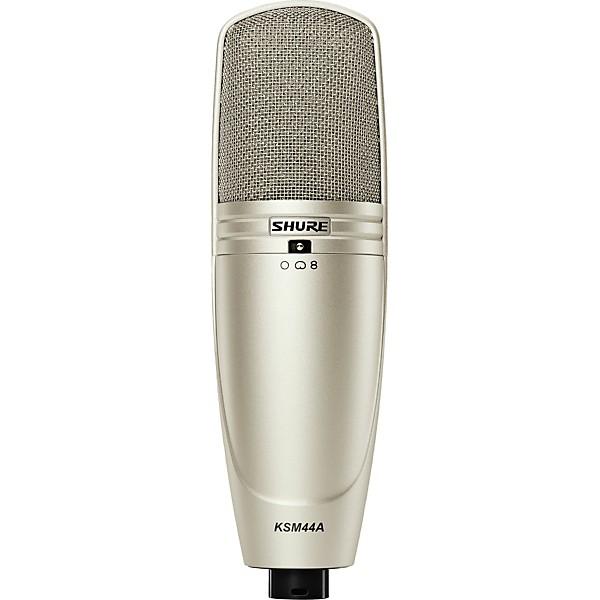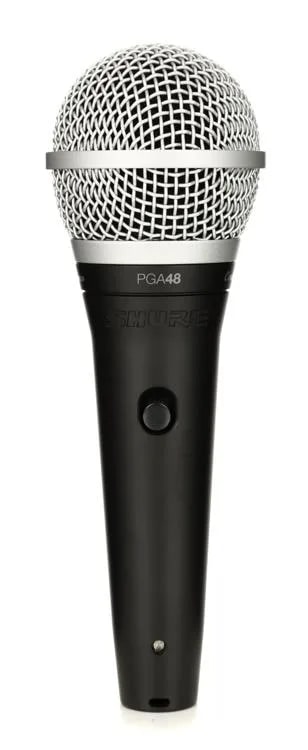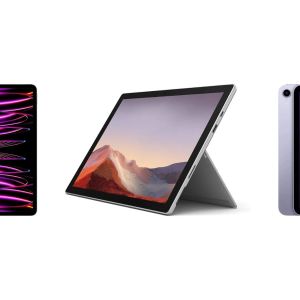When you buy through our links, we may earn an affiliate commission.
A new microphone isn't just another piece of gear—it's the start of something new. If you choose a durable and dependable enough mic, it'll likely last you through your whole music career without needing to be replaced.
Today we'll be ranking the microphones from one of the most time-tested brands in the industry: Shure.
Shure cemented their place in history with the SM57, which has been known for its versatility for over 50 years. You can still walk into a local music shop and walk out with one today.
Let's see how it stacks up against four of the other most iconic mics from Shure. Between these five picks, there is something for singers, podcasters, instrumentalists, and anyone else who needs a microphone.
Let's find which of these microphones is best for your specific uses, so you can get to creating!
Quick Summary of the Best Shure Microphones
- Shure SM57 (Overall Best Choice)
- Shure SM58 (Best for Live Vocals)
- Shure SM7B (Best for Studio Vocals)
- Shure KSM44A (Most Versatile Studio Mic)
- Shure PGA48 (Most Budget-Friendly Vocal Mic)
Best Shure Microphones
1. Overall Best Choice – Shure SM57

SPECS
- Price: $99
- Microphone type: Dynamic
- Polar pattern: Cardioid
- Frequency response: 40Hz - 15kHz
No shock here. The SM57 gets the number one spot because it has been putting studio-quality recording power in the hands of so many different amazing musicians for decades now.
If what you want is to record instruments, the SM57 is, without a doubt, the most versatile mic you can buy, and it remains at only $100.
"If it ain't broke, don't fix it" definitely applies to the SM57—in more ways than one. It's not likely to break, so you won't have to fix it. The design has never had to be changed either; it's worked for thousands of studios and has become universally recognized.
As a dynamic mic, it is the sturdiest type of microphone. You can place it inches from very loud sound sources like guitar amps or kick drums, and the mic will not be damaged.
The coil it uses to vibrate and generate an audio signal is protected inside the SM57's metal casing, making it able to withstand knocks and falls that other mics could only dream of surviving.
What really makes these mics such an industry standard is their versatility. There's not much to say about it that hasn't already been said other than "believe the hype."
You can use this mic in live shows or studio settings to mic any source clearly. When it comes to entertainment and the arts, how often can you get an industry-standard piece of gear for less than $100? Given what it can do, this mic is a screaming good deal.
The SM57 is the first microphone a lot of people buy. Simply connect an XLR cable and put it to work.
Many audio aficionados appreciate the transparent sound that the SM57 provides. It has a relatively flat frequency response with a slight boost to the upper mid, making it suited to pick up the crisp details of whatever you aim it at.
2. Best for Live Vocals – Shure SM58

SPECS
- Price: $99
- Microphone type: Dynamic
- Polar pattern: Cardioid
- Frequency response: 50Hz - 15kHz
Equally as valid of a choice, the Shure SM58 is durable and dependable, just like the 57. The only impactful difference between the two is the purposes they're designed to fill.
The SM58 is a vocal mic that is an extremely popular choice among live singers. So popular, in fact, that they're considered the industry standard.
What has earned it this reputation? Well, mostly the same things that make the SM57 an industry standard.
Back in the 60s, when this microphone was first produced, Shure's SM58 hit all the benchmarks of recording quality and durability that allowed for amazing studio albums and live sound. This microphone has kept studio-quality sound affordable for over 50 years.
Why spend more than you need to when the SM58 is $100, compatible with everything, and widely used all across the globe?
If you are looking for a stage mic, this is a perfect first choice because you won't have to worry about whether you'll get your money's worth. These mics can be beaters, joining you for gigs and on tour buses without breaking.
This mic is perfect for so many different scenarios. It's dependable whether you're busking on Santa Monica Blvd, playing a high-energy basement show, or even just giving a speech at the award ceremony. The durability really is the deciding factor.
This vocal microphone is designed to work for live vocals and studio vocals. You, as the artist, can decide what your specific purposes are for your microphone. The question is: What do you plan to record, and for what purpose?
If what you want the best microphones for vocals during live shows, then most people would say, "Just get an SM58!" Now that's a nice, straightforward conversation with the music shop guy.
If you plan to use your microphone to record instruments for live or studio settings, however, then get the #1 pick on this list instead.
Finally, if you want a studio mic that you don't plan on using for live vocals, then the SM58 is not necessarily the best choice, but it is one of many solid options. If you want what we think is the best Shure microphone for studio vocals, then you'll have to keep looking.
3. Best for Studio Vocals – Shure SM7B

SPECS
- Price: $399
- Microphone type: Dynamic
- Polar pattern: Cardioid
- Frequency response: 50Hz - 20kHz
Oh, that was easy! The Shure SM7B is a fantastic choice for studio vocals and the best value for most consumers in this category. So what makes it such a good value? It has impeccable sound quality.
The Shure SM7B is somewhat of a unique offering in the microphone space. While its build and intended use resemble those of a condenser mic, the SM7B is actually a dynamic mic, just like the previous two. This differentiates it from other similar mics in its price range.
Most studio mics with this build style are condenser mics. So the Shure SM7B already stands out for its durability relative to its competition. The rugged construction of dynamic microphones generally means a longer lifespan than condenser microphones.
This mic is ideal for home studio recording and professional recording. You can adjust the bass roll-off and presence boost controls to capture all the important characteristics of the vocal.
The Shure SM7B is also impressively capable of handling noise. Newly improved rejection of electromagnetic hum and internal shock isolation (or off-axis noise rejection) means your recordings will have virtually no unwanted noise. Long story short, the noise floor on this mic is impressively low.
Another reason to consider this microphone is that it comes with a couple of accessories that are actually useful. Shure has included a pop filter and detachable windscreen with the product, which can be game changers in certain environments or with certain vocal talents. (Let's be honest, whenever you use a pop filter, you'll be glad you did.)
It has a wide diaphragm and, and likewise, a wider frequency response.
Although it is primarily marketed as a vocal microphone (and certainly has the classic look of one), it is a capable instrument mic as well.
4. Most Versatile Studio Mic – Shure KSM44A

SPECS
- Price: $999
- Microphone type: Condenser
- Polar pattern: Cardioid, Omni, Figure-8
- Frequency response: 20Hz - 20kHz
The Shure KSM44A is a multi-pattern condenser mic, which makes it both versatile and high quality. While not as durable as the Shure dynamic mics, the KSM44A delivers sound quality that is a cut above almost any other microphone you can find.
The slight dip in durability relative to dynamic mics is not a problem, so long as you don't knock the KSM44A around. This is, after all, not designed to take a beating. It's designed to deliver the best possible sound quality in any studio situation.
Dual 1-inch, externally biased, ultra-thin, 24 Karat gold-layered, low-mass diaphragms provide a superior frequency response to every other mic on this list (and just about every other mic on the market). There is also a switchable 15 dB pad for handling extremely high sound pressure levels.
It comes with Prethos® Advanced Preamplifier Technology, which gives it an insanely low noise floor. Your recordings will be nearly free of unwanted noise or distortion (even more so than recordings with the SM7B, which was already fantastic at eliminating noise!).
It is a truly rewarding experience to hear your vocal, guitar, drum, or sound effect part sounding absolutely pristine during playback.
Being able to switch between three polar patterns is useful as well because it means this mic is a chameleon that can fit any role it needs to.
Use the cardioid polar pattern for a single vocal or instrument, the figure eight polar pattern for conversations between two people on opposite sides, and the omni polar pattern to pick up the sound from all sources in a room.
The transparent sound quality and amazingly wide frequency response make this product a great choice as a room mic to record an entire band.
Whether the audio source is close, far, high-pitched, low-pitched, quiet, or soft, it doesn't matter. The KSM44A will perform well under all these circumstances.
Make no mistake: Although this is an excellent microphone, we would NOT recommend it to beginners. But if you are looking for a microphone to record crystal-clear audio from any source, then this may be the last studio mic you'll ever need.
5. Most Budget-Friendly Vocal Mic – Shure PGA48

SPECS
- Price: $39
- Microphone type: Dynamic
- Polar pattern: Cardioid
- Frequency response: 70Hz - 15kHz
And finally, the Shure PGA48. Shure is already renowned as a budget-friendly brand, but why not highlight one of their offerings that is even more budget-friendly than the rest?
The PGA48 is one of the cheapest vocal microphones you can find, at only $40. Let's examine the benefits and limitations of this mic and see if it is a good fit for you.
This product is essentially the budget version of the SM58. If you are an experienced professional musician, then you'll be better off just getting the SM58 instead of this one.
But if you are just entering the world of music and want something usable and dependable that won't break the bank, then this is the mic for you. For more budget-friendly options, check out our roundup of the best mics for under $100.
Although it can be used to mic any sound source, it is best suited as a vocal mic. The cardioid pickup pattern makes it a suitable stage mic for live shows or presentations. As a dynamic mic with such a low price tag, it is not a purchase you'll have to worry about.
Compared to the SM58, the PGA48 provides a slightly less clear and full sound, with feedback rejection that is not quite as good (but still impressive for the price).
Perhaps the most notable limitation is its reduced frequency response that tapers off at 70Hz. This makes the mic not suitable for recording low frequencies like sub-bass. We wouldn't recommend using this mic to record bass or drums.
This is a perfect stage mic for bands who are just starting out and are still in the hectic garage phase. The sound quality, given the price, is definitely decent, but once again, it is the durability that really makes this mic shine.
Best Shure Microphones Buyer's Guide
This buyer's guide provides at-a-glance info about Shure and microphones in general. If you are able to answer these questions, then you will know which features should matter most to you in your search for the perfect microphone.
What Purpose You Need the Mic For
When you look for a microphone, this is by far the most important question to ask yourself. Microphones all have very different intended purposes, so you'll want to find one that is designed to do what you need it to do.
Do you want a live vocal mic, a live instrument mic, a studio vocal mic, a studio instrument mic, or one that can do all of the above? Fortunately, this list covers all those bases, so you won't be left high and dry.
Budget
Shure has been around for a long time, and they have products available in all price ranges. If you can determine what your budget is early on, then you'll have no trouble finding a great mic that is affordable to you.
We recommend not spending less than $40 or more than $1,000 (wide range, we know).
Durability
Durability is important for any microphone. Ribbon mics are particularly fragile; even one drop can render them unusable. Fortunately, this list contains only dynamic and condenser mics. If you treat them carefully, they should last you years and years.
Frequency Response
The frequency response determines which frequencies can be picked up cleanly. The wider the frequency response, the better.
The PGA48 tapers off at 70Hz, making it not suitable to record bass. Meanwhile, the KSM44A tapers off at 20Hz, meaning it can record frequencies as low as the human ear can hear.
The 40Hz - 15kHz range of the SM57 is adequate for most people.
User Reviews
When buying any piece of gear, it is always a good idea to look at the user reviews first. We recommend buying a mic with a large number of five-star reviews.
Accessories
See which accessories or ad-ons come with your mic. If you can bundle in a pop filter or XLR cable with your microphone, then this will save you another purchase because both of these are things you are going to need anyway.
Other useful accessories include wind filters, stands, or noise-reducing covers.
Frequently Asked Questions (FAQs)
Is Shure a trusted name in microphones?
Yes. When it comes to live sound and recordings, Shure is arguably the most trusted name in microphones.
What is a polar pattern and why is it important?
A polar pattern determines where the sound source must be relative to the mic in order to be picked up clearly. It is important to know the polar pattern of your microphone so you know where the sound source needs to be.
For example, if you sing into the back side of a microphone that has a cardioid pickup pattern, then your vocal will not be picked up correctly.
Do Shure microphones come with a warranty?
Shure products come with a two-year limited warranty. If the product becomes defective within those two years, you are eligible to get it replaced.
Make sure to go over the warranty information with a sales rep if you are confused because there are usually multiple warranty options available.
What are the best techniques for recording instruments, recording vocals, and performing live vocals?
The best recording technique depends on the volume of the sound source, the characteristics of the recording space, and the settings on the preamp. Generally speaking, holding the mic six to eight inches from the sound source is a safe bet.
Check your preamp to make sure your input signal is not peaking or clipping because this will cause unwanted distortion and could result in an unusable take.
When it comes to live vocals, there's basically no wrong way to do it! Some singers prefer to sing six inches away from the mic, but others like to hold the mic so close that their lips touch it the whole time. Experiment with different performing styles and find out what sounds best for you.
In Conclusion
You've made it to the end! We hope you've enjoyed this exploration of some of the best microphones from Shure.
Whichever mic you end up buying, you'll have it for years and enjoy every minute of it. After all, the SM57 has remained iconic for decades because of its industry-defining reliability.
As an artist, you have something unique to say, and if you make it heard, the world will be better off for it. Grab a mic and get to work!
Cut the cords and capture crisp audio! Discover the best wireless microphone for iPhone—shop now!
Make your voice heard! Explore our curated list of the best microphones for YouTube and boost your video production.
